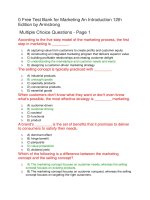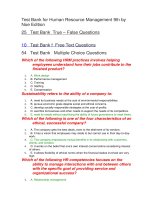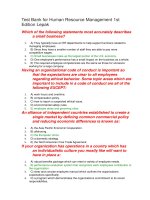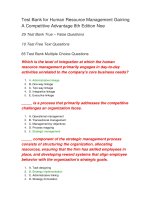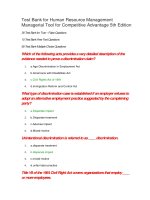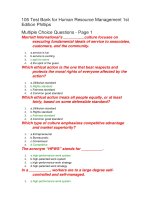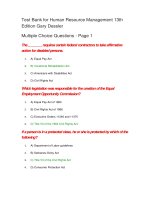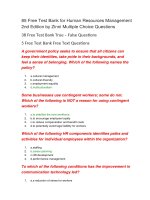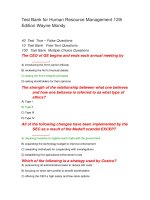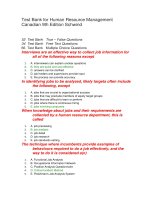Test bank for human resource management 12th edition by ivancevich
Bạn đang xem bản rút gọn của tài liệu. Xem và tải ngay bản đầy đủ của tài liệu tại đây (277.03 KB, 26 trang )
1
Student: ___________________________________________________________________________
1.
When an organization is really concerned about people, its total philosophy, culture, and orientation will
reflect this belief.
True False
2.
During the Industrial Revolution, a new kind of employee emerged—a boss who wasn't the owner.
True False
3.
Welfare secretaries bridged the gap between labor and the government.
True False
4.
A series of experiments conducted at the Hawthorne facility of Western Electric, the Hawthorne Studies,
was completed in order to determine the effect of illumination on workers and their output.
True False
5.
Without managerial participation in HRM activities and programs, a company is likely to have major
human resource problems.
True False
6.
A study found that a 1 standard deviation improvement in human resource practices was associated with a
$41,000 increase in shareholder wealth per employee.
True False
7.
For employees to be productive, they do not necessarily need to feel that the job is right for their abilities
but must feel that they are being treated equitably.
True False
8.
For employees to be productive, they must feel that the job is right for their abilities and that they are
being treated equitably.
True False
9.
Satisfied employees are automatically more productive.
True False
10. Both satisfied and unsatisfied employees may perform equally in quantitative terms, such as processing
the same number of insurance claims per hour.
True False
11. Ethical principles should apply to all HRM activities.
True False
12. A decreased sense of empowerment is emphasized in firms using a learning framework.
True False
13. If improperly managed, the effectiveness of human resources declines less quickly than other
resources.
True False
14. Outsourcing of HRM functions is likely to be discontinued as decision makers search for ways to
improve the financial and operating performance of firms.
True False
15. A line person typically supports the primary functions of a company, such as marketing and production,
by providing advice, counsel, and information.
True False
Full file at />
16. All of the following terms have been used to describe the HR function except:
A. Human resource management
B. Personnel
C. Industrial relations
D. Trade relations
17. The history of HRM can be traced to England, where craftspeople organized themselves into
_______________.
A. guilds
B. shires
C. trades
D. unions
18. Effective HRM focuses on _______________ rather than record keeping, written procedure, or rules.
A. action
B. intuition
C. experience
D. precedent
19. The HRM unit is should be _______________.
A. future-oriented
B. people-oriented
C. global-oriented
D. All of the choices are correct
20. Scientific management and welfare work are two concurrent human resource approaches that began in the
19th century and, along with _______________, merged during the era of the world wars.
A. labor relations
B. unionism
C. industrial psychology
D. the Big Five theory
21. ____________________ has been summarized as science, not rules of thumb; harmony, not discord;
cooperation, not individualism; and maximum output, not restricted output.
A. Industrial psychology
B. Human resource management
C. Scientific management
D. The Industrial Revolution
22. ____________________ focus(es) on the maximum well-being of the worker.
A. Industrial psychology
B. Human resource management
C. Scientific management
D. All management theories
23. The maximum well being of _______________ was the focus of industrial psychology.
A. the company
B. the worker
C. production
D. management
24. ____________________ in his book, Psychology and Industrial Efficiency, initiated the field of
industrial psychology.
A. Fritz Roelthisberger
B. Elton Mayo
C. Hugo Munsterberg
D. Frederick W. Taylor
Full file at />
25. The Hawthorne studies pointed out ______________________________.
A. the effects of illumination on workers and their output
B. the importance of the social interaction and work group on output and satisfaction
C. the positive impact of scientific management
D. All of the choices are correct
26. Until the 1960s, the personnel was considered to be concerned only with _________________
employees.
A. union
B. white-collar
C. blue-collar
D. management
27. ________ characterized "personnel management" as "partly a file clerk's job, partly a housekeeping job,
partly a social worker's job, and partly firefighting, heading off union trouble."
A. Elton Mayo
B. Peter Drucker
C. Hugo Munsterberg
D. Jack Walsh
28. All of the following are key concepts that should be applied by HRM except:
A. Analyzing and solving problems from a profit-oriented point of view.
B. Assessing costs or benefits of recruitment and training.
C. Using planning models that include realistic, challenging, specific, and meaningful goals.
D. Emphasizing the strategic importance of expendable employees.
29. Which of the following are associated with the "traditional" view of HRM?
A. Short-term results
B. Flexibility
C. People development
D. All of the choices are correct
30. Which of the following are not associated with the "traditional" view of HRM?
A. Participative Culture
B. Flexibility
C. People development
D. All of the choices are correct
31. All of the following contributed to the era of HRM accountability except:
A. Widespread downsizing.
B. A surplus of skilled workers.
C. An increasingly complex and competitive world.
D. An increasingly diverse workforce.
32. HRM and _______________ must work together to achieve the level of organizational effectiveness
required to compete locally and internationally.
A. marketing
B. distribution
C. manufacturing
D. every other function
33. The text identifies three elements that are needed for firms to be effective. Which of the following were
included in these elements?
A. HRM
B. Mission and Strategy
C. Organizational Structure
D. All of the choices are correct
Full file at />
34. One problem in making strategic planning decisions regarding people is that all other resources are
evaluated in terms of _______________ and, in most organizations, people are not.
A. market share
B. life cycle
C. money
D. productivity
35. Evidence has shown that implementing high performance management practices results in all of the
following except:
A. Profitability gains.
B. Stock price increases.
C. Higher company survival rates.
D. A resurgence of creativity.
36. There is now evidence that an increase in the use of "people first" practices results in all of the following
except:
A. A decrease in turnover
B. Lower productivity
C. Higher profits
D. Higher sales
37. The contributions HRM makes to organizational effectiveness include which of the following?
A. Communicating HRM policies to all employees.
B. Helping to maintain ethical policies and socially responsible behavior.
C. Managing increased urgency and faster cycle time.
D. All of the choices are correct
38. A number of studies have found that implementing high performance management practices results in
____________________.
A. profitability gains
B. higher company survival rate
C. increased overall costs
D. Both A and B are correct
39. To prepare for Generation Y employees, managers should consider providing more _______________
praise.
A. public
B. written
C. sincere
D. specific
40. To improve performance, people must see _______________ in the rewards that are given.
A. potential
B. consistency
C. justice
D. seniority
41. Employees born between 1980 and 2000 make up _________.
A. Generation J
B. Generation X
C. Generation Y
D. Generation Z
42. Employees born between 1965 and 1979 make up _________.
A. the baby boomers
B. Generation X
C. Generation Y
D. Generation Z
Full file at />
43. A sound quality of work life program assumes that a job and the work environment should be structured
to meet as many of the _______________ needs as possible.
A. company's
B. stockholders'
C. worker's
D. consumers'
44. Which of the following statements concerning employee job satisfaction is false?
A. Satisfied employees are not automatically more productive.
B. Satisfied employees always perform better on quantitative measures.
C. Unsatisfied employees are absent more often than satisfied employees.
D. Unsatisfied employees quit more often than satisfied employees.
45. Organizational inefficiencies result in all of the following except:
A. Poor productivity
B. Spiraling benefits costs
C. Better quality
D. Dissatisfied workers
46. QWL refers to which of the following?
A. Quality of Work Life
B. Quality of Work Levels
C. Quantity of Work Levels
D. Qualitative Worker Leasing
47. In comparison to satisfied employees, unsatisfied employees tend to ___________ work outputs.
A. produce lower quantity
B. produce lower quality
C. produce variable
D. All of the choices are correct
48. The human resource manager plays an important role in showing by _______________ that each
employee is important and will be treated ethically.
A. example
B. demand
C. decree
D. persuasion
49. A key area within the organizational learning framework is __________________.
A. organizational humanization
B. leadership behavior
C. job enlargement
D. All of the choices are correct
50. _____________ is the process of recruiting, developing and retaining top employee talent.
A. Talent management
B. Employee development
C. Talent maximization
D. Employee maximization
51. Nearly all new trends in telecommuting, outsourcing of HRM practices, family medical leave, child care,
and relocation assistance can be traced to the emergence of new lifestyles and _______________.
A. an aging population
B. an influx of immigrants
C. rising wages
D. a decrease in available workers
Full file at />
52. Frameworks for cycle time reduction focus on effective management of ___________.
A. products
B. services
C. human resources
D. All of the choices are correct
53. Effective HR departments set specific, measurable objectives to be accomplished within
_______________ time limits.
A. unspecified
B. the shortest possible
C. specified
D. flexible
54. The term operating managers would typically apply to which of the following?
A. Operations clerk
B. VP of Human Resources
C. Production supervisor
D. Both A and C
55. As organizations look for ways to improve performance, the decision to outsource some, all, or none of
the HRM activities is being made with ________ empirical support.
A. little
B. moderate
C. extensive
D. no
56. Motivations to outsource HRM activities include which of the following?
A. Reduction of costs
B. Increased friability
C. Elimination of "line staff conflict"
D. Both A and B
57. Within an organization which of the following would be typically considered to be a "staff" function?
A. Marketing
B. Production
C. HR
D. Both A and C
58. Conflict between HR employees and operating managers typically occur due to differing perspectives on
___________________.
A. profit orientation
B. authority
C. urgency
D. All of the choices are correct
59. A well-formulated HRM strategy will help aggregate and allocate a firm's resources into a unique entity
on the basis of all of the following except:
A. Internal strengths and weaknesses
B. The strength of local unions
C. Changes in the environment
D. Anticipated actions of competitors
60. Because HR executives play an increasingly dominant role in strategic planning, they must now be
familiar with:
A. Investments
B. Advertising
C. Production control
D. All of the choices are correct
Full file at />
61. According to one study, the national average ratio of HR specialist to employees is ________.
A. 1 to 20
B. 1 to 50
C. 1 to 100
D. 1 to 200
62. A firm's HRM _________ the pattern or plan that integrates the major objectives, policies, and
procedures into a cohesive whole.
A. map shows
B. policy is
C. strategy is
D. table shows
63. The ______________ of an organization or department are the goals it seeks to achieve.
A. objectives
B. purpose
C. intent
D. articles
64. An organization makes an objective more specific by developing _______________.
A. plans
B. goals
C. procedures
D. policies
65. A _______________ is a general guide that expresses limits within which action should occur.
A. policy
B. procedure
C. process
D. practice
66. Which of the following represent the appropriate sequence?
A. Objectives, Strategy, Procedures, Policies
B. Objectives, Strategy, Policies, Procedures
C. Strategy, Objectives, Policies, Procedures
D. Strategy, Objectives, Procedures, Policies
67. A _______________ tells a manager how to do a particular activity.
A. policy
B. procedure
C. process
D. directive
68. In large organizations, ____________ are collected and put into manuals, usually called standard
operating procedures (SOPs).
A. HRM policies
B. HRM procedures
C. HRM processes
D. HRM guides
69. An ________________ is a specific direction to action.
A. HRM policy
B. HRM procedure
C. HRM process
D. HRM practice
Full file at />
70. The personnel commission at the federal level is called the:
A. Supreme Court
B. Equal Employment Opportunity Commission
C. U.S. Office of Personnel Management
D. U.S. Civil Service Commission
71. Name three benefits that companies attribute to telecommuting.
72. Human Resource Management (HRM) consists of numerous activities. Name at least five of them.
73. Name two factors that contributed to the development of personnel departments.
74. Despite the appeal that strategic HRM is important, many organizations have had a difficult time
adopting a strategic perspective. List two reasons why this may be the case.
75. The HRM department must communicate to numerous groups. Discuss these groups.
Full file at />
76. In the past decade, there have been rapid, turbulent, and often strained developments in the relationship
between employers and employees. Describe these developments and what do they mean to HR
managers.
77. How does organizational learning relate to cycle time?
78. What is the primary reason that operating managers, such as supervisors, department heads, and vice
presidents, are involved in HRM activities?
79. When is the conflict between HR employees and operating managers most pressing?
80. What is a firm's HRM strategy and why should a firm have one?
81. What are HRM policies and how are they helpful to management?
Full file at />
82. What are organizational objectives?
83. What is the relationship between HRM policies and Procedures?
84. Does the acronym SOP apply to HRM policies or procedures?
85. What may be a negative impact of having too many HRM policies and procedures?
86. Explain how action-oriented HRM differs from people-oriented HRM.
87. In 1995, an explosion and fire occurred at the Malden Mills plant in Lawrence, Massachusetts. The plant
owner, Aaron Feuerstein, opted to pay 1400 displaced workers for three months while the plant was being
rebuilt rather than pocket the insurance money, even though it cost him $15 million in personal funds. If
you had been the owner, would you have made the same decision? Why or why not?
Full file at />
88. Many organizations have had a difficult time adopting a strategic perspective toward HRM. Why?
89. Identify five contributions that HRM makes to organizational effectiveness. Helping the organization
reach its goals is an example.
90. Identify five HRM criteria or components that can be used to measure organizational effectiveness or
ineffectiveness. Grievance rate is an example.
Full file at />
1 Key
1.
(p. 4)
When an organization is really concerned about people, its total philosophy, culture, and orientation
will reflect this belief.
TRUE
Difficulty: 1 Easy
Ivancevich - Chapter 01 #1
2.
(p. 6)
During the Industrial Revolution, a new kind of employee emerged—a boss who wasn't the
owner.
TRUE
Difficulty: 1 Easy
Ivancevich - Chapter 01 #2
3.
(p. 7)
Welfare secretaries bridged the gap between labor and the government.
FALSE
Welfare secretaries bridged the gap between labor and management.
Difficulty: 1 Easy
Ivancevich - Chapter 01 #3
4.
(p. 7)
A series of experiments conducted at the Hawthorne facility of Western Electric, the Hawthorne
Studies, was completed in order to determine the effect of illumination on workers and their
output.
TRUE
Difficulty: 1 Easy
Ivancevich - Chapter 01 #4
5.
(p. 10)
Without managerial participation in HRM activities and programs, a company is likely to have major
human resource problems.
TRUE
Difficulty: 1 Easy
Ivancevich - Chapter 01 #5
6.
(p. 11)
A study found that a 1 standard deviation improvement in human resource practices was associated
with a $41,000 increase in shareholder wealth per employee.
TRUE
Difficulty: 1 Easy
Ivancevich - Chapter 01 #6
7.
(p. 13)
For employees to be productive, they do not necessarily need to feel that the job is right for their
abilities but must feel that they are being treated equitably.
TRUE
For years, the HRM function was not linked to the corporate profit margin because management did
not understand the positive impact that reducing turnover and improving the skills of employees could
have on the firm's bottom line.
Difficulty: 1 Easy
Ivancevich - Chapter 01 #7
8.
(p. 13)
For employees to be productive, they must feel that the job is right for their abilities and that they are
being treated equitably.
TRUE
Difficulty: 1 Easy
Ivancevich - Chapter 01 #8
9.
(p. 13)
Satisfied employees are automatically more productive.
FALSE
Difficulty: 1 Easy
Ivancevich - Chapter 01 #9
Full file at />
10.
(p. 13)
Both satisfied and unsatisfied employees may perform equally in quantitative terms, such as
processing the same number of insurance claims per hour.
TRUE
Difficulty: 1 Easy
Ivancevich - Chapter 01 #10
11.
(p. 14)
Ethical principles should apply to all HRM activities.
TRUE
Difficulty: 1 Easy
Ivancevich - Chapter 01 #11
12.
(p. 14)
A decreased sense of empowerment is emphasized in firms using a learning framework.
FALSE
An increased sense of empowerment is emphasized in firms using a learning framework.
Difficulty: 2 Medium
Ivancevich - Chapter 01 #12
13.
(p. 15)
If improperly managed, the effectiveness of human resources declines less quickly than other
resources.
FALSE
If improperly managed, the effectiveness of human resources declines more quickly than other
resources.
Difficulty: 2 Medium
Ivancevich - Chapter 01 #13
14.
(p. 15)
Outsourcing of HRM functions is likely to be discontinued as decision makers search for ways to
improve the financial and operating performance of firms.
FALSE
Outsourcing of HRM functions is likely to continue as decision makers search for ways to improve the
financial and operating performance of firms. Outsourcing can reduce costs and improve flexibility.
Difficulty: 2 Medium
Ivancevich - Chapter 01 #14
15.
(p. 15)
A line person typically supports the primary functions of a company, such as marketing and
production, by providing advice, counsel, and information.
FALSE
Advice, counsel, and information are typically provided a staff person.
Difficulty: 2 Medium
Ivancevich - Chapter 01 #15
16.
(p. 4)
All of the following terms have been used to describe the HR function except:
A. Human resource management
B. Personnel
C. Industrial relations
D. Trade relations
Difficulty: 1 Easy
Ivancevich - Chapter 01 #16
Full file at />
17.
(p. 5)
The history of HRM can be traced to England, where craftspeople organized themselves into
_______________.
A. guilds
B. shires
C. trades
D. unions
Difficulty: 1 Easy
Ivancevich - Chapter 01 #17
18.
(p. 5)
Effective HRM focuses on _______________ rather than record keeping, written procedure, or
rules.
A. action
B. intuition
C. experience
D. precedent
Difficulty: 3 Hard
Ivancevich - Chapter 01 #18
19.
(p. 5)
The HRM unit is should be _______________.
A. future-oriented
B. people-oriented
C. global-oriented
D. All of the choices are correct
Difficulty: 2 Medium
Ivancevich - Chapter 01 #19
20.
(p. 6)
Scientific management and welfare work are two concurrent human resource approaches that began in
the 19th century and, along with _______________, merged during the era of the world wars.
A. labor relations
B. unionism
C. industrial psychology
D. the Big Five theory
Difficulty: 3 Hard
Ivancevich - Chapter 01 #20
21.
(p. 6)
____________________ has been summarized as science, not rules of thumb; harmony, not discord;
cooperation, not individualism; and maximum output, not restricted output.
A. Industrial psychology
B. Human resource management
C. Scientific management
D. The Industrial Revolution
Difficulty: 2 Medium
Ivancevich - Chapter 01 #21
22.
(p. 7)
____________________ focus(es) on the maximum well-being of the worker.
A. Industrial psychology
B. Human resource management
C. Scientific management
D. All management theories
Difficulty: 2 Medium
Ivancevich - Chapter 01 #22
23.
(p. 7)
The maximum well being of _______________ was the focus of industrial psychology.
A. the company
B. the worker
C. production
D. management
Difficulty: 2 Medium
Ivancevich - Chapter 01 #23
Full file at />
24.
(p. 7)
____________________ in his book, Psychology and Industrial Efficiency, initiated the field of
industrial psychology.
A. Fritz Roelthisberger
B. Elton Mayo
C. Hugo Munsterberg
D. Frederick W. Taylor
Difficulty: 2 Medium
Ivancevich - Chapter 01 #24
25.
(p. 7)
The Hawthorne studies pointed out ______________________________.
A. the effects of illumination on workers and their output
B. the importance of the social interaction and work group on output and satisfaction
C. the positive impact of scientific management
D. All of the choices are correct
Difficulty: 2 Medium
Ivancevich - Chapter 01 #25
26.
(p. 7)
Until the 1960s, the personnel was considered to be concerned only with _________________
employees.
A. union
B. white-collar
C. blue-collar
D. management
Difficulty: 2 Medium
Ivancevich - Chapter 01 #26
27.
(p. 7)
________ characterized "personnel management" as "partly a file clerk's job, partly a housekeeping
job, partly a social worker's job, and partly firefighting, heading off union trouble."
A. Elton Mayo
B. Peter Drucker
C. Hugo Munsterberg
D. Jack Walsh
Difficulty: 2 Medium
Ivancevich - Chapter 01 #27
28.
(p. 8)
All of the following are key concepts that should be applied by HRM except:
A. Analyzing and solving problems from a profit-oriented point of view.
B. Assessing costs or benefits of recruitment and training.
C. Using planning models that include realistic, challenging, specific, and meaningful goals.
D. Emphasizing the strategic importance of expendable employees.
Difficulty: 2 Medium
Ivancevich - Chapter 01 #28
29.
(p. 8)
Which of the following are associated with the "traditional" view of HRM?
A. Short-term results
B. Flexibility
C. People development
D. All of the choices are correct
Difficulty: 2 Medium
Ivancevich - Chapter 01 #29
30.
(p. 8)
Which of the following are not associated with the "traditional" view of HRM?
A. Participative Culture
B. Flexibility
C. People development
D. All of the choices are correct
Difficulty: 2 Medium
Ivancevich - Chapter 01 #30
Full file at />
31.
(p. 9)
All of the following contributed to the era of HRM accountability except:
A. Widespread downsizing.
B. A surplus of skilled workers.
C. An increasingly complex and competitive world.
D. An increasingly diverse workforce.
Difficulty: 2 Medium
Ivancevich - Chapter 01 #31
32.
(p. 9)
HRM and _______________ must work together to achieve the level of organizational effectiveness
required to compete locally and internationally.
A. marketing
B. distribution
C. manufacturing
D. every other function
Difficulty: 2 Medium
Ivancevich - Chapter 01 #32
33.
(p. 10)
The text identifies three elements that are needed for firms to be effective. Which of the following
were included in these elements?
A. HRM
B. Mission and Strategy
C. Organizational Structure
D. All of the choices are correct
Difficulty: 2 Medium
Ivancevich - Chapter 01 #33
34.
(p. 10)
One problem in making strategic planning decisions regarding people is that all other resources are
evaluated in terms of _______________ and, in most organizations, people are not.
A. market share
B. life cycle
C. money
D. productivity
Difficulty: 1 Easy
Ivancevich - Chapter 01 #34
35.
(p. 11)
Evidence has shown that implementing high performance management practices results in all of the
following except:
A. Profitability gains.
B. Stock price increases.
C. Higher company survival rates.
D. A resurgence of creativity.
Difficulty: 1 Easy
Ivancevich - Chapter 01 #35
36.
(p. 11)
There is now evidence that an increase in the use of "people first" practices results in all of the
following except:
A. A decrease in turnover
B. Lower productivity
C. Higher profits
D. Higher sales
Difficulty: 2 Medium
Ivancevich - Chapter 01 #36
37.
(p. 11)
The contributions HRM makes to organizational effectiveness include which of the following?
A. Communicating HRM policies to all employees.
B. Helping to maintain ethical policies and socially responsible behavior.
C. Managing increased urgency and faster cycle time.
D. All of the choices are correct
Difficulty: 2 Medium
Ivancevich - Chapter 01 #37
Full file at />
38.
(p. 11)
A number of studies have found that implementing high performance management practices results in
____________________.
A. profitability gains
B. higher company survival rate
C. increased overall costs
D. Both A and B are correct
Difficulty: 2 Medium
Ivancevich - Chapter 01 #38
39.
(p. 12)
To prepare for Generation Y employees, managers should consider providing more _______________
praise.
A. public
B. written
C. sincere
D. specific
Difficulty: 2 Medium
Ivancevich - Chapter 01 #39
40.
(p. 12)
To improve performance, people must see _______________ in the rewards that are given.
A. potential
B. consistency
C. justice
D. seniority
Difficulty: 1 Easy
Ivancevich - Chapter 01 #40
41.
(p. 12)
Employees born between 1980 and 2000 make up _________.
A. Generation J
B. Generation X
C. Generation Y
D. Generation Z
Difficulty: 2 Medium
Ivancevich - Chapter 01 #41
42.
(p. 12)
Employees born between 1965 and 1979 make up _________.
A. the baby boomers
B. Generation X
C. Generation Y
D. Generation Z
Difficulty: 2 Medium
Ivancevich - Chapter 01 #42
43.
(p. 13)
A sound quality of work life program assumes that a job and the work environment should be
structured to meet as many of the _______________ needs as possible.
A. company's
B. stockholders'
C. worker's
D. consumers'
Difficulty: 2 Medium
Ivancevich - Chapter 01 #43
44.
(p. 13)
Which of the following statements concerning employee job satisfaction is false?
A. Satisfied employees are not automatically more productive.
B. Satisfied employees always perform better on quantitative measures.
C. Unsatisfied employees are absent more often than satisfied employees.
D. Unsatisfied employees quit more often than satisfied employees.
Difficulty: 2 Medium
Ivancevich - Chapter 01 #44
Full file at />
45.
(p. 13)
Organizational inefficiencies result in all of the following except:
A. Poor productivity
B. Spiraling benefits costs
C. Better quality
D. Dissatisfied workers
Difficulty: 1 Easy
Ivancevich - Chapter 01 #45
46.
(p. 13)
QWL refers to which of the following?
A. Quality of Work Life
B. Quality of Work Levels
C. Quantity of Work Levels
D. Qualitative Worker Leasing
Difficulty: 1 Easy
Ivancevich - Chapter 01 #46
47.
(p. 13)
In comparison to satisfied employees, unsatisfied employees tend to ___________ work outputs.
A. produce lower quantity
B. produce lower quality
C. produce variable
D. All of the choices are correct
Difficulty: 2 Medium
Ivancevich - Chapter 01 #47
48.
(p. 13)
The human resource manager plays an important role in showing by _______________ that each
employee is important and will be treated ethically.
A. example
B. demand
C. decree
D. persuasion
Difficulty: 1 Easy
Ivancevich - Chapter 01 #48
49.
(p. 13)
A key area within the organizational learning framework is __________________.
A. organizational humanization
B. leadership behavior
C. job enlargement
D. All of the choices are correct
Difficulty: 2 Medium
Ivancevich - Chapter 01 #49
50.
(p. 13)
_____________ is the process of recruiting, developing and retaining top employee talent.
A. Talent management
B. Employee development
C. Talent maximization
D. Employee maximization
Difficulty: 2 Medium
Ivancevich - Chapter 01 #50
51.
(p. 14)
Nearly all new trends in telecommuting, outsourcing of HRM practices, family medical leave,
child care, and relocation assistance can be traced to the emergence of new lifestyles and
_______________.
A. an aging population
B. an influx of immigrants
C. rising wages
D. a decrease in available workers
Difficulty: 2 Medium
Ivancevich - Chapter 01 #51
Full file at />
52.
(p. 14)
Frameworks for cycle time reduction focus on effective management of ___________.
A. products
B. services
C. human resources
D. All of the choices are correct
Difficulty: 2 Medium
Ivancevich - Chapter 01 #52
53.
(p. 14)
Effective HR departments set specific, measurable objectives to be accomplished within
_______________ time limits.
A. unspecified
B. the shortest possible
C. specified
D. flexible
Difficulty: 2 Medium
Ivancevich - Chapter 01 #53
54.
(p. 14)
The term operating managers would typically apply to which of the following?
A. Operations clerk
B. VP of Human Resources
C. Production supervisor
D. Both A and C
Difficulty: 2 Medium
Ivancevich - Chapter 01 #54
55.
(p. 15)
As organizations look for ways to improve performance, the decision to outsource some, all, or none
of the HRM activities is being made with ________ empirical support.
A. little
B. moderate
C. extensive
D. no
Difficulty: 2 Medium
Ivancevich - Chapter 01 #55
56.
(p. 15)
Motivations to outsource HRM activities include which of the following?
A. Reduction of costs
B. Increased friability
C. Elimination of "line staff conflict"
D. Both A and B
Difficulty: 2 Medium
Ivancevich - Chapter 01 #56
57.
Within an organization which of the following would be typically considered to be a "staff" function?
(p. 15)
A.
B.
C.
D.
Marketing
Production
HR
Both A and C
Difficulty: 1 Easy
Ivancevich - Chapter 01 #57
58.
(p. 15)
Conflict between HR employees and operating managers typically occur due to differing perspectives
on ___________________.
A. profit orientation
B. authority
C. urgency
D. All of the choices are correct
Difficulty: 1 Easy
Ivancevich - Chapter 01 #58
Full file at />
59.
(p. 17)
A well-formulated HRM strategy will help aggregate and allocate a firm's resources into a unique
entity on the basis of all of the following except:
A. Internal strengths and weaknesses
B. The strength of local unions
C. Changes in the environment
D. Anticipated actions of competitors
Difficulty: 2 Medium
Ivancevich - Chapter 01 #59
60.
(p. 17)
Because HR executives play an increasingly dominant role in strategic planning, they must now be
familiar with:
A. Investments
B. Advertising
C. Production control
D. All of the choices are correct
Difficulty: 2 Medium
Ivancevich - Chapter 01 #60
61.
(p. 17)
According to one study, the national average ratio of HR specialist to employees is ________.
A. 1 to 20
B. 1 to 50
C. 1 to 100
D. 1 to 200
Difficulty: 2 Medium
Ivancevich - Chapter 01 #61
62.
(p. 17)
A firm's HRM _________ the pattern or plan that integrates the major objectives, policies, and
procedures into a cohesive whole.
A. map shows
B. policy is
C. strategy is
D. table shows
Difficulty: 2 Medium
Ivancevich - Chapter 01 #62
63.
(p. 17)
The ______________ of an organization or department are the goals it seeks to achieve.
A. objectives
B. purpose
C. intent
D. articles
Difficulty: 2 Medium
Ivancevich - Chapter 01 #63
64.
(p. 18)
An organization makes an objective more specific by developing _______________.
A. plans
B. goals
C. procedures
D. policies
Difficulty: 2 Medium
Ivancevich - Chapter 01 #64
65.
(p. 18)
A _______________ is a general guide that expresses limits within which action should occur.
A. policy
B. procedure
C. process
D. practice
Difficulty: 2 Medium
Ivancevich - Chapter 01 #65
Full file at />
66.
(p. 18)
Which of the following represent the appropriate sequence?
A. Objectives, Strategy, Procedures, Policies
B. Objectives, Strategy, Policies, Procedures
C. Strategy, Objectives, Policies, Procedures
D. Strategy, Objectives, Procedures, Policies
Difficulty: 2 Medium
Ivancevich - Chapter 01 #66
67.
(p. 18)
A _______________ tells a manager how to do a particular activity.
A. policy
B. procedure
C. process
D. directive
Difficulty: 2 Medium
Ivancevich - Chapter 01 #67
68.
(p. 18)
In large organizations, ____________ are collected and put into manuals, usually called standard
operating procedures (SOPs).
A. HRM policies
B. HRM procedures
C. HRM processes
D. HRM guides
Difficulty: 2 Medium
Ivancevich - Chapter 01 #68
69.
(p. 19)
An ________________ is a specific direction to action.
A. HRM policy
B. HRM procedure
C. HRM process
D. HRM practice
Difficulty: 2 Medium
Ivancevich - Chapter 01 #69
70.
(p. 21)
The personnel commission at the federal level is called the:
A. Supreme Court
B. Equal Employment Opportunity Commission
C. U.S. Office of Personnel Management
D. U.S. Civil Service Commission
Difficulty: 3 Hard
Ivancevich - Chapter 01 #70
71.
Name three benefits that companies attribute to telecommuting.
(p. 3)
Any three of the following: (1) lower real estate costs (2) reduced turnover (3) increased productivity
(4) increased ability to comply with workplace laws
Difficulty: 2 Medium
Ivancevich - Chapter 01 #71
72.
Human Resource Management (HRM) consists of numerous activities. Name at least five of them.
(p. 5)
Any five of the following: (1) Equal Employment Opportunity compliance (2) job analysis (3) human
resource planning (4) employee recruitment, selection, motivation, and orientation (5) performance
evaluation and compensation (6) training and development (7) labor relations (8) safety, health, and
wellness.
Difficulty: 3 Hard
Ivancevich - Chapter 01 #72
Full file at />
73.
Name two factors that contributed to the development of personnel departments.
(p. 7)
Any two of the following: (1) changes in technology (2) growth of organizations (3) the rise of
unions (4) government concern and intervention concerning working people (5) the human relations
movement
Difficulty: 3 Hard
Ivancevich - Chapter 01 #73
74.
(p. 8)
Despite the appeal that strategic HRM is important, many organizations have had a difficult time
adopting a strategic perspective. List two reasons why this may be the case.
First, many organizations take a short-run approach and focus only on current performance. This is not
surprising given the emphasis by Wall Street and many stockholders on achieving attractive quarterly
performance results. Second, many HR managers do not have a strategic perspective. They are
narrowly trained and educated and pay primarily attention to their area of expertise—compensation,
labor law, performance evaluation, and other HR areas. The have insufficient knowledge of finance,
accounting, marketing, and production. Third, most executives simply categorize HRM in a traditional
manner. They fail to see how HRM can contribute to strategic initiatives, goals, and programs.
Finally, it is difficult to develop metrics for HRM activities. Placing values on and tracking HRM
programs is difficult. For example, the measures of effectiveness for health wellness programs are not
easy to develop and discuss. Thus, providing funds to programs that have less measurable results is
difficult to implement.
Difficulty: 2 Medium
Ivancevich - Chapter 01 #74
75.
The HRM department must communicate to numerous groups. Discuss these groups.
(p. 13)
Communicating HRM programs does not just happen; "a manager has to work at it constantly."
HRM's responsibility is "to communicate in the fullest possible sense both in tapping ideas, opinions,
and feelings of customers, noncustomers, regulators, and other external publics, and in understanding
the views of internal human resources. The other facet of this responsibility is communicating
managerial decisions to relevant publics in their own language." Closely related to communication
within the organization is representation of the organization to those outside: trade unions and local,
state, and federal government bodies that pass laws and issue regulations affecting HRM. The HRM
department must also communicate effectively with other top-management people (e.g., marketing,
production, and research and development) to illustrate what it can offer these areas in the form of
support, counsel, and techniques, and to increase its contribution to the overall strategic mission and
goals of the organization.
Difficulty: 2 Medium
Ivancevich - Chapter 01 #75
76.
(p. 14)
In the past decade, there have been rapid, turbulent, and often strained developments in the
relationship between employers and employees. Describe these developments and what do they mean
to HR managers.
New trends and changes have occurred in telecommuting, outsourcing, HRM practices, family
medical leave, child care, spousal relocation assistance, pay for skills, benefit cost-sharing, unionmanagement negotiations, testing, and many other HRM areas of interest. Nearly all of these trends
and changes can be traced to the emergence of new lifestyles and an aging population. What these
changes mean to HR managers is that new, flexible approaches must be initiated and used effectively
without jeopardizing the survival of the organization. HR managers must cope with trends and
changes while still contributing to the organization.
Difficulty: 2 Medium
Ivancevich - Chapter 01 #76
Full file at />
77.
How does organizational learning relate to cycle time?
(p. 14)
Organizational learning provides a framework for increasing cycle time. Key areas within this
framework are leadership behaviors, a culture that encourages and rewards learning, and an emphasis
on learning to work more efficiently, quickly, and confidently. Quicker and more flexible decision
making and an increased sense of empowerment are also emphasized in firms using a learning
framework.
Difficulty: 2 Medium
Ivancevich - Chapter 01 #77
78.
(p. 15)
What is the primary reason that operating managers, such as supervisors, department heads, and vice
presidents, are involved in HRM activities?
Operating managers are involved in HRM activities because they are responsible for the effective use
of all the resources at their disposal, including human resources.
Difficulty: 3 Hard
Ivancevich - Chapter 01 #78
79.
When is the conflict between HR employees and operating managers most pressing?
(p. 16)
When joint decisions must be made on such issues as discipline, working conditions, termination, and
so on.
Difficulty: 2 Medium
Ivancevich - Chapter 01 #79
80.
What is a firm's HRM strategy and why should a firm have one?
(p. 17)
A firm's HRM strategy is the pattern or plan that integrates the major objectives, policies and
procedures into a cohesive whole. A well-formulated HRM strategy will help aggregate and allocate
a firm's resources into a unique entity on the basis of its internal strengths and weaknesses, changes in
the environment, and the anticipated actions of competitors.
Difficulty: 2 Medium
Ivancevich - Chapter 01 #80
81.
What are HRM policies and how are they helpful to management?
(p. 18)
An HRM policy is a general guide that expresses limits within which action should occur. Policies
are developed from past problem areas or for potential problem areas that management considers
important enough to warrant policy development. Policies free managers from having to make
decisions in areas in which they have less competence or on matters with which they do not wish to
become involved. Policies ensure some consistency in behavior and allow managers to concentrate on
decisions in which they have the most experience and knowledge.
Difficulty: 2 Medium
Ivancevich - Chapter 01 #81
82.
What are organizational objectives?
(p. 17)
The objectives of an organization or department are the goals it seeks to achieve—its reason for
existence.
Difficulty: 1 Easy
Ivancevich - Chapter 01 #82
Full file at />
83.
What is the relationship between HRM policies and Procedures?
(p. 18)
After the broadest policies are developed, some organizations develop procedures and rules. These
are more specific plans that limit the choices of managers and employees. Procedures and rules are
developed for the same reasons as policies.
Difficulty: 2 Medium
Ivancevich - Chapter 01 #83
84.
Does the acronym SOP apply to HRM policies or procedures?
(p. 19)
An HRM procedure or rule is a specific direction to action. It tells a manager how to do a particular
activity. In large organizations, procedures are collected and put into manuals, usually called standard
operating procedures (SOPs).
Difficulty: 3 Hard
Ivancevich - Chapter 01 #84
85.
What may be a negative impact of having too many HRM policies and procedures?
(p. 19)
Organizations must be careful to have consistent decision making that flows from a well-developed,
but not excessive, set of policies and procedures. Some organizations, in effect, eliminate managerial
initiative by trying to develop policies and procedures for everything.
Difficulty: 2 Medium
Ivancevich - Chapter 01 #85
86.
Explain how action-oriented HRM differs from people-oriented HRM.
(p. 5)
Action-oriented HRM emphasizes the solution of employment problems in order to achieve
organizational objectives and facilitate employees' development and satisfaction. People-oriented
HRM treats each employee as an individual and offers services and programs to meet the individual's
needs.
Difficulty: 2 Medium
Ivancevich - Chapter 01 #86
87.
(p. 5)
In 1995, an explosion and fire occurred at the Malden Mills plant in Lawrence, Massachusetts. The
plant owner, Aaron Feuerstein, opted to pay 1400 displaced workers for three months while the plant
was being rebuilt rather than pocket the insurance money, even though it cost him $15 million in
personal funds. If you had been the owner, would you have made the same decision? Why or why
not?
Varies by student.
Difficulty: 2 Medium
Ivancevich - Chapter 01 #87
88.
Many organizations have had a difficult time adopting a strategic perspective toward HRM. Why?
(p. 8)
First, organizations take a short-run approach and focus only on current performance. Second, many
human resource managers do not have a strategic perspective. Third, it is difficult to develop metrics
for (measure) HRM activities.
Difficulty: 3 Hard
Ivancevich - Chapter 01 #88
Full file at />
89.
(p. 11)
Identify five contributions that HRM makes to organizational effectiveness. Helping the organization
reach its goals is an example.
Any five of the following. (a) Using the skills and abilities of the workforce efficiently. (b) Providing
well-trained and motivated employees. (c) Helping employees achieve job satisfaction and selfactualization.
(d) Developing and maintaining a quality of work life that makes employment in the organization
desirable. (e) Communicating HRM policies to all employees. (f) Helping to maintain ethical policies
and socially responsible behavior. (g) Managing change to the mutual advantage of individuals,
groups, the enterprise, and the public.
Difficulty: 3 Hard
Ivancevich - Chapter 01 #89
90.
(p. 10)
Identify five HRM criteria or components that can be used to measure organizational effectiveness or
ineffectiveness. Grievance rate is an example.
Any five of the following: performance, legal compliance, employee satisfaction, absenteeism,
turnover, training effectiveness and return on investment, accident rates, goal attainment, efficient use
of employees, hiring and retention rates of good employees.
Difficulty: 3 Hard
Ivancevich - Chapter 01 #90
Full file at />
